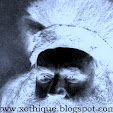From Hong, 1989
About Me

- Jonathan
- Adalbert is a forum for me, to post ephemera, photography, poetry, occasional travel notes, and various spontaneous motions. Cover photo: Parsonage where my great-grandfather spent his early years. Taken near Liegnitz, Silesia, ca. 1870. The "xothique" portion of the web address is a nod to Clark Ashton Smith's fictional continent of Zothique.
Friday, October 26, 2012
Thursday, October 25, 2012
Thursday, October 18, 2012
Wednesday, October 17, 2012
Saturday, October 13, 2012
Thursday, October 11, 2012
Wednesday, October 10, 2012
Saturday, October 6, 2012
Parallel readings of Richard Brautigan and Raymond Carver
Last month I read at the same time an old edition of Trout Fishing in America (with its quaint typewriter-like text) by Richard Brautigan and What we talk about when we talk about Love by Raymond Carver. I had read little or nothing by either author before, although their reputations are inescapable. When I bought the two books together at the king of bookstores, the clerk said: That's an interesting combination, or something to that effect.
There is no reason to link the two authors, other than I finally felt compelled to read them. As such things happen, though, they have some parallels and were contemporaries -- both were born in the 1930s and died fairly young in the 1980s, Brautigan at the age of 49 and Carver at 50. Both were born in the Pacific Northwest. Both writers used relatively simple language and wrote in a sparing manner.
Carver -- or Carver's material as procrusteanly edited, at any rate, in the edition I read -- merits his high regard. At times head-scratchingly truncated -- what the hell happens to the old injured couple? -- his encrypted glimpses of savagery (as in Tell the Women we're going) and human incompleteness (alcoholism, missing limbs, muteness) are conveyed with the simplest economy.
The famous cover of Brautigan's Trout Fishing in America suggests some of the differences between the two works. Brautigan and his companion, with their free-form garb, in Washington Square in San Francisco, distill the essence of the counterculture in the late 1960s, when the book was published (whether or not Brautigan was fully on board with the hippies is another issue). The novel itself was actually written during the Kennedy era and is more of a late Beat Generation or proto- hippie work. No psychotropic drugs are referenced -- the drug of this book is alcohol. In contrast with Carver's naturalism, Brautigan uses language in a way that is dreamlike and in places liberated from semantics. "Sandbox minus John Dillinger equals what?" But Brautigan's writing is suffused with an underlying note of tragedy, as with Carver. There's always a melancholy along with Brautigan's humor, as when he writes of reading, in Life Magazine, about Hemingway's suicide, anticipating his own.
There is no reason to link the two authors, other than I finally felt compelled to read them. As such things happen, though, they have some parallels and were contemporaries -- both were born in the 1930s and died fairly young in the 1980s, Brautigan at the age of 49 and Carver at 50. Both were born in the Pacific Northwest. Both writers used relatively simple language and wrote in a sparing manner.
Carver -- or Carver's material as procrusteanly edited, at any rate, in the edition I read -- merits his high regard. At times head-scratchingly truncated -- what the hell happens to the old injured couple? -- his encrypted glimpses of savagery (as in Tell the Women we're going) and human incompleteness (alcoholism, missing limbs, muteness) are conveyed with the simplest economy.
The famous cover of Brautigan's Trout Fishing in America suggests some of the differences between the two works. Brautigan and his companion, with their free-form garb, in Washington Square in San Francisco, distill the essence of the counterculture in the late 1960s, when the book was published (whether or not Brautigan was fully on board with the hippies is another issue). The novel itself was actually written during the Kennedy era and is more of a late Beat Generation or proto- hippie work. No psychotropic drugs are referenced -- the drug of this book is alcohol. In contrast with Carver's naturalism, Brautigan uses language in a way that is dreamlike and in places liberated from semantics. "Sandbox minus John Dillinger equals what?" But Brautigan's writing is suffused with an underlying note of tragedy, as with Carver. There's always a melancholy along with Brautigan's humor, as when he writes of reading, in Life Magazine, about Hemingway's suicide, anticipating his own.
Friday, October 5, 2012
Subscribe to:
Comments (Atom)








